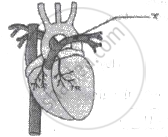Advertisements
Advertisements
प्रश्न
Explain the Term
Double Circulation
उत्तर
In mammals the heart produces two separate circulations, the pulmonary to the lungs and systemic to the rest of the body. These two separate circulations are jointly called double circulation. From the right ventricle deoxygenated blood goes to the lung for purification and
comes back to left auricle through pulmonary vein after purification which is known as pulmonary circulation,. Distribution of blood from the left ventricle to different parts of the body and back to hearts as deoxygenated blood is known as systemic circulation.
APPEARS IN
संबंधित प्रश्न
What is meant by the term 'single circulation'?
Which blood vessel does not carry any carbon dioxide?
Blood in the human body circulates twice for making one complete round through the body. Explain.
The diagram represents the ‘closed system’ or ‘double circulation’ of blood in mammals.
Justify the above statement.
State two structural and two functional differences between the arteries and veins.
State the changes in the composition of blood as it passes through the following organs:
(a) Lungs (b) Gut (c) Liver (d) Kidneys.
Why is the circulation in man referred to as double circulation?
In the given diagram, 'X' indicates ______

Why is the small intestine in herbivores longer than in carnivores?
Complete the following flow diagram of double circulation:

From where to where do the following blood vessel carry blood?
Hepatic portal vein
Name these:
Two phases of circulation of blood in human body
